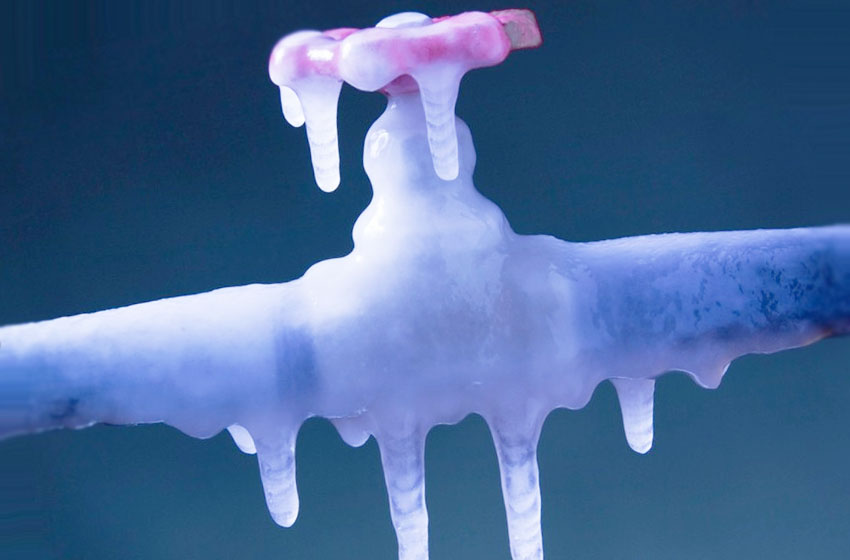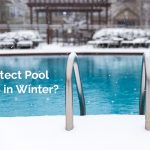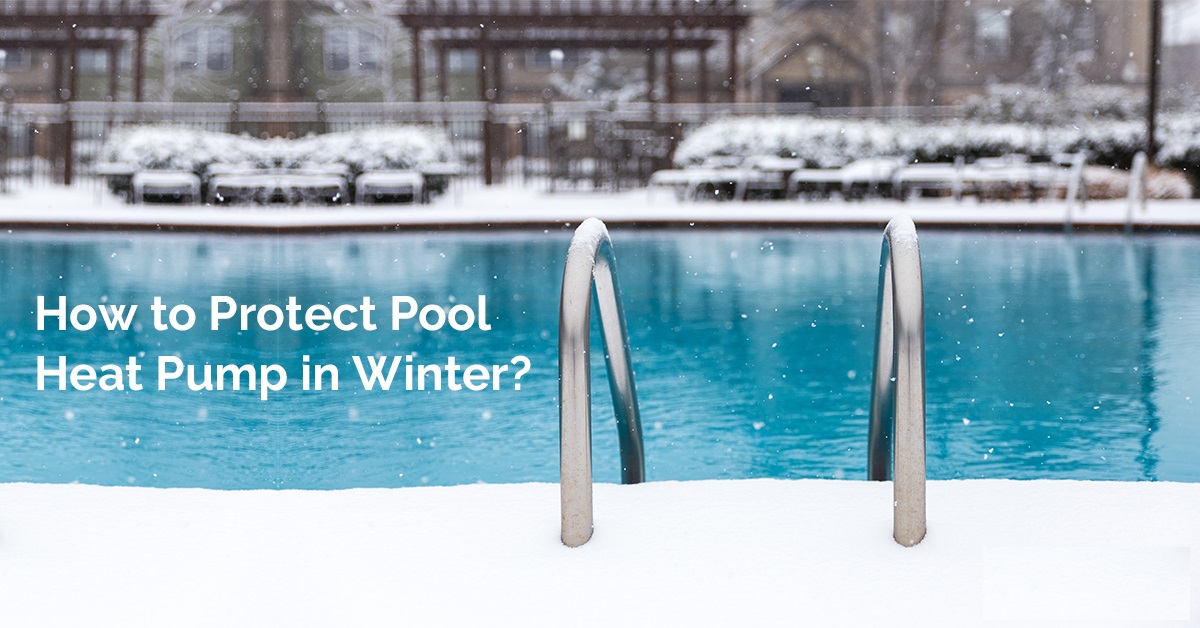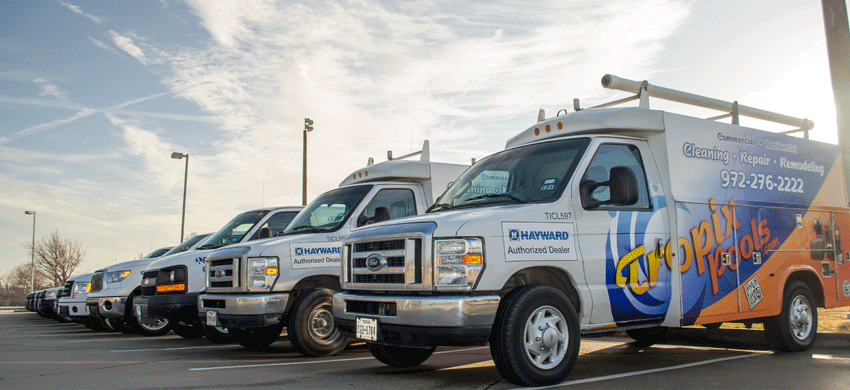Although moving water should not freeze, keeping your pool warm is the most effective way to avoid freeze damage, period. As long as you can keep your pool water a constant temperature, above the freezing point of 32 degrees, you should be safe. If you cannot do this for any reason including heating ability or equipment failure, please see some helpful steps from Tropix Pools below.
If you have a cover, keep the pool and equipment covered to lock in heat
Using a solar cover is the best way to keep your pool warm and retain the heat from your heater. Covering your pool is just like putting a lid on a pot of water: it helps warm it up faster while improving heat retention. If you are able to do so, use a cover to reduce unnecessary heat loss.
If you have a pool equipment cover, put it on as this will help keep the equipment and pipes warm. If you do not have a pool equipment cover, wrapping equipment pipes with towels will insulate plumbing lines and help prevent freezing. Even pool noodles can serve as good insulation around pipes. Do not use any type of electric heaters, electric blankets, portable gas heaters, or heat lamps on or near your pool pump and filter as they can damage equipment or cause a fire. 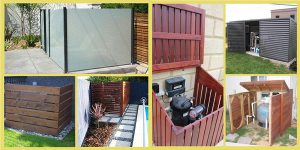
If you happen to have purchased swimming pool anti-freeze, put swimming pool anti-freeze directly into your pool lines. Add one gallon of anti-freeze for every 10 feet of plumbing. Never use automotive anti-freeze in a pool. Automotive anti-freeze is toxic for swimmers and can cause serious damage to pool equipment, plumbing lines, and pool surfaces.
If you can’t run the equipment due to power failure or mechanical failure,
If you are physically capable and knowledgeable you may shut off power at circuit breaker. Remove the drain plugs on the pool equipment first at the pump (2), filter (1), heater (2), Chlorinator (1), etc. Open filter Air bleeder to assist in faster drain down. This will quickly drain down the plumbing, and then cover the equipment with heavy blankets. Remove pool skimmer, drain and store in warm area. You can also wrap the above ground PVC plumbing with a heating cable for pipes, which can prevent freezing pipes to well below freezing. Once weather subsides, we can schedule a repair technician to come out and assess damage. The YouTube video below may help determine where equipment is located in the event of a power outage. Pool Freeze Protection Power Outage Link
Run your pool heater 12 hours/day or more to stay above freezing temperatures
Depending on your location, the average amount of time you’ll need to run your pool heater will be close to 12 hours or more. This will help keep your pool water above freezing temperatures. Do not cover pool heater. Pool Heater Leslies Pentair
Use a Freeze Protector to automate water circulation
A Freeze Protector will help prevent freeze damage. As the name implies, it protects your swimming pool and pipes from freezing up. It works by automatically powering on your pump and pool heater when freezing temperatures hit. Pool Freeze Protector Amazon
If you have a freeze protector, monitor the system for failure; make sure that it is operating properly. Be sure All Valves are Open; skimmers, drains, vacuum; returns, spa jets, fountains. Keep your filter pump running 24 hours to keep your pipes from freezing
In the event you do not have a Freeze Protector,
To protect your equipment from cracking and prevent your pipes from freezing, run your filter pump 24 hours a day. This does a few things:
• It keeps your water circulated
• It helps maintain a constant water temperature
• It assists your pool heater by circulating the heated water
For these conditions, using a variable speed pump is much more efficient than a single speed pump. Not only can you set a variable speed pump to a low setting to save energy, but you can also speed it up when emergency freeze prevention is needed.
In the same vein, the best way to keep your pool pump freezing is by never giving it the chance to get cold enough. This means running it as long as it takes to keep the water warm.
If your pump does freeze, the best course of action is to remove the drain plug and relieve pressure from the system. 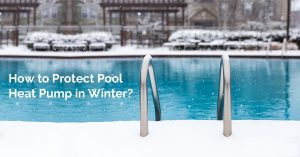
Use a “skimmer bottle” to protect the pool skimmer from cracking
Your pool skimmer is easy to forget about. It’s the unsung hero of your swimming pool. It sits quietly in the background, trapping all the unwanted intruders and debris floating on the surface. The gizzmo seen here does a great job. Skimmer Bottle Gizzmo
During the winter months, your pool skimmer is equally as important for assisting with water flow. But, since it’s mostly made out of thin PVC, it can be subject to serious cracking.
Here’s how to make it:
• Grab an empty water bottle
• Fill it 1/3 with pool antifreeze
• Screw the cap back on
• Drop the bottle into the skimmer
The bottle works by acting as a pressure absorber, relieving the stress that freezing puts on the walls of your skimmer.
Set all valves to OPEN (or FILTER) for optimal heat distribution
Although this might be a given for some, it’s an important tip nonetheless.
In most cases, the valves in your pool plumbing system will be set to OPEN as your pool runs. There might be a few cases when you change the valve position, or partially close one of them.
During the winter time, keeping all of your valves on OPEN is the most effective way to keep your water warm and circulated. So walk over to your pump and filter and do a quick double check to make sure all your valves are in the right positions.
Angle pool jets upwards to prevent surface freezing
Although it might seem like a big deal, adjusting the angle of your swimming pool jets has a noticeable effect on your overall heating distribution. While it might not make your pool heater faster, it will change the way it heats.
Consider this: When a container of water freezes, it starts from the surface and works its way down. Your pool follows the same rules.
By angling your return jets upwards, you send a constant blast of heat towards the surface. This does an excellent job of fending off the surface ice that forms in those rare, frigid temperatures.
Always Maintain proper water level
Last, but certainly not least: maintaining a proper water level.
The winter might just be the time when it’s MOST important to keep track of your water level.
Water levels that are too high or low can cause everything from circulation issues to equipment damage.
Otherwise, keep your water level at exactly mid skimmer level. This allows it to flow at a constant pace throughout your pool system, which means more consistent water temperature.
If a thick sheet of ice has formed, it is important to add water below the sheet in order to prevent liner damage. If the ice sheet becomes thicker than ¼ to ½ inch, it will put pressure on your pool tile and skimmers as the ice expands. Most pool tile is frost-free, but you should keep the water under the perimeter pool tile band to be safe. Ice can crack tile or loosen the grout, letting small pieces of tile come loose. You should keep the pump running to prevent water from freezing within the plumbing.
If outside water pipes have frozen, siphoning water from an indoor sink with a garden hose is an option.
If Your Pool Has Frozen
Protecting pool pipes from freezing. Pool pipes located above the ground can crack if they pump is not running when temperatures dip below 32° for several hours. PVC pipes and valves are very rigid. Water inside of PVC pipes turning to ice will first expand to fill every available air space inside the pipe and equipment, and if expansion continues it will crack pipes, valves, pumps, filters and/or heaters. 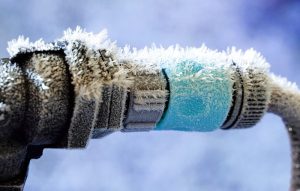
If you can’t run the equipment due to power failure or mechanical failure, shut off power at circuit breaker. Remove the drain plugs on the pool equipment first at the pump (2), filter (1), heater (2), Chlorinator (1), etc. Open filter Air bleeder to assist in faster drain down. This will quickly drain down the plumbing, and then cover the equipment with heavy blankets. Remove pool skimmer, drain and store in warm area. You can also wrap the above ground PVC plumbing with a heating cable for pipes, which can prevent freezing pipes to well below freezing. Once weather subsides, we can schedule a repair technician to come out and access damage. Do NOT turn back on equipment until equipment is completely thawed.
Pool Surface is Frozen solid; Pump is Running, What Else Can I Do?
• Monitor the system for failure; make sure it is operating properly.
• Monitor the water level, if your pool has a leak; add water to support an ice sheet.
• Be sure All Valves are Open; skimmers, drains, vacuum; returns, spa jets, fountains.
• Keep children and pets safely indoors. No walking or playing with the ice sheet.
• Do not attempt to break the ice sheet, or melt the ice sheet. Do not add hot water.
• Ice sheets grow slowly, about 1/4″ per day in most cases.
• Ice sheets of over 2″ exert considerable outward pressure.
My Pool Fountain or Water Features are Solid Ice or Not Running?
• Remove nozzles or spray head, using boiling hot water if needed to melt ice.
• Open the valve, and pour 1 gallon Antifreeze into the pipe with hose and funnel.
• Do not attempt to break off solid ice formations into the pool.
I have a Pool Cleaner; Can I run it During Freezing Temps?
• Pool Cleaners can be operated during Freezing Temps if needed.
• Do not operate a cleaner if the pool surface is frozen over, or in icy conditions.
• Drain the pool cleaner fully after use in cold temps. Store indoors if possible.
I have an Automatic Cover, Can I Operate During Freezing Temps?
• Automatic covers are best not opened when the pool surface is frozen.
• Covering the pool may not prevent it from freezing over, but will slow the process.
• Keep the cover pumped off, to avoid an ice sheet on top of the cover.
I have a Variable Speed Pump, is Low-Speed OK for Freezing Temps?
• In most cases low speed is sufficient, but use medium just in case.
• Be sure that all lines to and from the pool are open, and water is moving.
• Override any programming for less than 24 hours per day. Run VS Pumps 24/7.
I have a Salt Pool, Can a Salt Pool Freeze?
• Salt pools will freeze just like any pool, although it has a slightly lower freezing point.
• Salt in a saltwater pool will not protect pool equipment or pipes from freeze damage.
Is it OK to Backwash the Filter During Freezing Temps?
• Yes, you can perform regular maintenance tasks, water won’t freeze instantly.
• If there is a large ice sheet on the pool however, add water to maintain ice sheet support.
My Pool Is Leaking and Frozen Over?
• Add water to maintain level, to support the heavy ice sheet.
• Ice sheets can fall at angles that damage pool liners, lights, ladders, or wall fittings.
• Ice sheets grow slowly, about 1/4″ per day in most cases.
• Ice sheet thickness of over 2″ exerts considerable outward pressure.
• When weather subsides, schedule a time for a repair tech to come and assess damage.
Pool Builder Prosper, TX Pool Builder Celina, TX Pool Builder Van Alstyne, TX Pool Builder Plano, TX Pool Builder Frisco, TX Pool Builder McKinney, TX Pool Builder Melissa, TX Pool Builder Dallas, TX Pool Builder Anna, TX Pool Builder Little Elm, TX Pool Builder Southlake, TX Pool Builder Gunter, TX Pool Builder Crossroads, TX Pool Builder Aubrey, TX Pool Builder Highland Park, TX Pool Builder Allen, TX Pool Builder Argyle, TX Pool Builder Flower Mound, TX Pool Builder Fairview, TX Pool Builder Rockwall, TX Pool Builder Rowlett, TX Pool Builder Lantana, TX Pool Builder Southlake, TX Pool Builder Trophy Club, TX Pool Builder Keller, TX Pool Builder Lakewood, TX Pool Builder Preston Hollow, TX Pool Builder Sherman, TX


